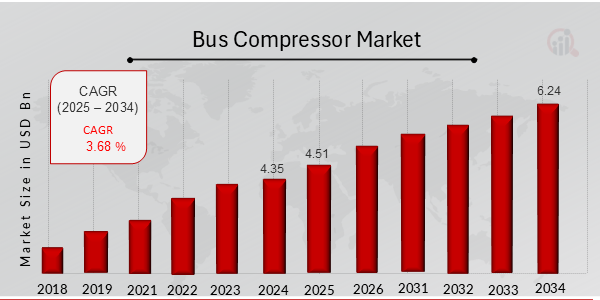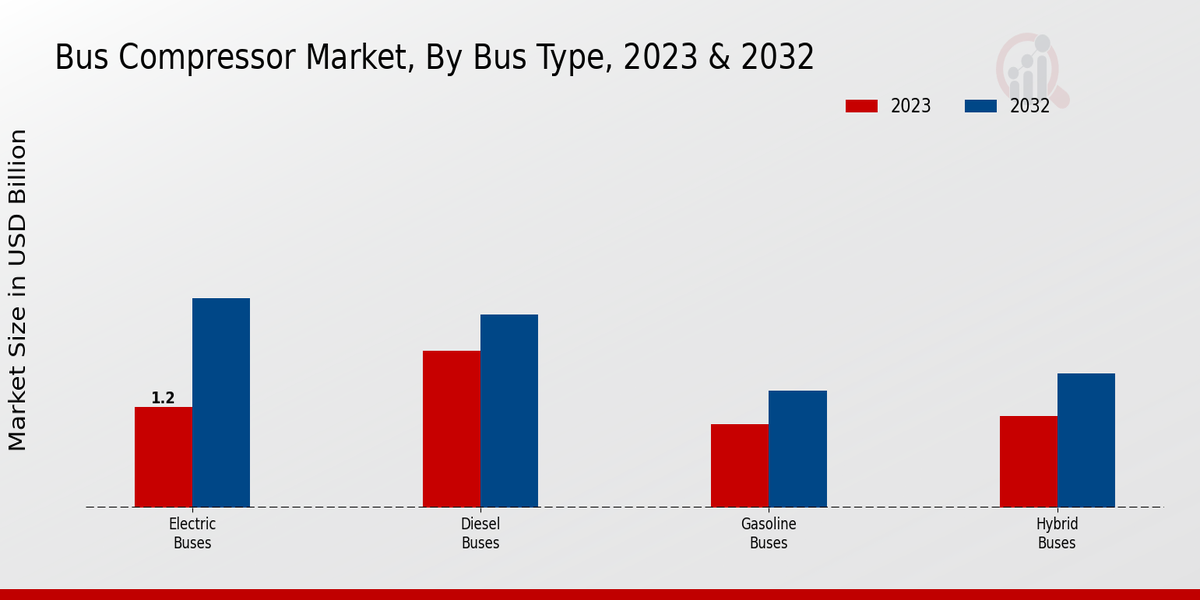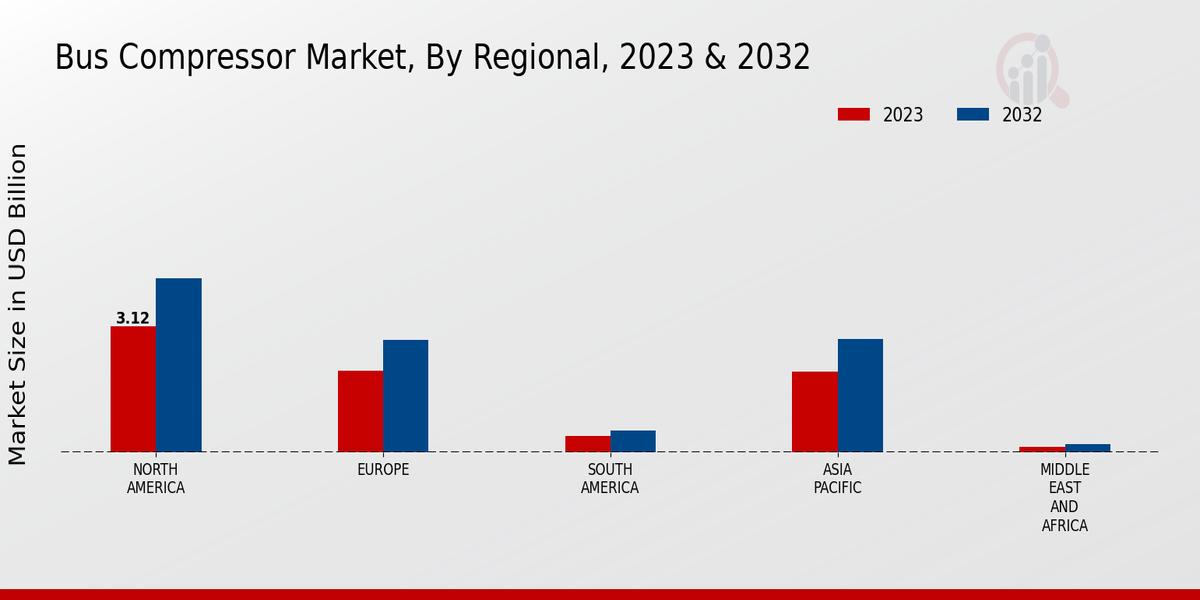Bus Compressor Market Overview:
As per MRFR analysis, the Bus Compressor Market Size was estimated at 4.35 (USD Billion) in 2024. The Bus Compressor Market Industry is expected to grow from 4.51 (USD Billion) in 2025 to 6.24 (USD Billion) till 2034, at a CAGR (growth rate) is expected to be around 3.68% during the forecast period (2025 - 2034).
Key Bus Compressor Market Trends Highlighted
The growth rate of the Bus Compressor Market is currently supported by the increasing ‘cooling’ needs of so-called air conditioning systems. The growth of the market is propelled by increasing urban population, government legislation regarding passenger comfort and safety as well as increasing income levels. In addition, there are increasing possibilities due to the new generation of compressor technology available, such as variable displacement compressors or electric compressors.
Recently, popular trends featured the usage of environmentally viable refrigerants and the application of compressors as a part of telematics systems. These systems help to keep the compressor functional during the monitoring of its activities so that the total downtime of the compressors can be decreased, and the working efficiency is improved. Also, high performance and luxury buses market segment is also expected to grow considerably in the forecast period.
Increased number of air conditioned buses, tightening of emission standards and more stringent passenger safety and comfort regulations are the key factors for further growth of the Bus Compressor Market. There are several avenues for value addition by new product development in areas such as developing better and greener compressors and adding more useful and advanced technologies.

Source: Primary Research, Secondary Research, Market Research Future Database and Analyst Review
Bus Compressor Market Drivers
Increased Demand for Luxury Buses
One of the most significant drivers of growth in the Bus Compressor Market is the increasing demand for luxury buses. Nowadays, more and more travelers and businesses are turning to luxury buses. The reason is that such buses provide a more comfortable and convenient way to travel and thus, become increasingly more popular. In addition, there is a growing interest in tourism in the world, and more people leave their homes and move for vacations and travels.
As a result, people need ways to make their travels more enjoyable or comfortable, and luxury buses can be a very comfortable way of travelling. For this reason, the popularity of luxury buses will continue to grow, and so will the need for bus compressors.
Stringent Emission Regulations
Stringent emission regulations are another key driver of growth in the Bus Compressor Market. In many countries, governments are implementing stricter emission standards for vehicles, including buses. This is driving up demand for bus compressors that can help buses meet these standards. Bus compressors play a vital role in reducing emissions by controlling the flow of air and fuel into the engine. By using advanced bus compressors, manufacturers can improve the fuel efficiency of buses and reduce their emissions.
The growing demand for buses that meet stringent emission standards is expected to continue in the coming years, which will drive demand for bus compressors.
Advancements in Bus Compressor Technology
There are also significant technological developments in the sphere of bus air conditioning itself. In recent years, new, improved bus compressors that are more efficient, reliable, and durable have been developed and successfully gained market share. Bus manufacturers receive benefits from producing vehicles fitted with advanced bus compressors, and it is certain that the demand for these units will grow in the foreseeable future.
Bus Compressor Market Segment Insights:
Bus Compressor Market Bus Type Insights
The Bus Compressor Market is divided into Electric Buses, Diesel Buses, Gasoline Buses, and Hybrid Buses. Among all the segments, Electric Buses are expected to have the highest growth rates during the period of the analysis as a result of the government’s increasing initiatives to induce people to switch to electric vehicles, as well as the strict ecological emission norms.
The need for transporting people in a more sustainable way is increasing, while the number of concerns related to the environment is becoming more sustainable. Currently, the Electric Bus segment amounts to about 1.2 billion USD in 2023 and is expected to reach a share of 2.5 billion USD in 2032, expanding at a CAGR of 8.5%. Public providers of transportation services opt for electric vehicles more often, while private organizations take the same course to derive benefits in terms of operating costs, emissions reduction, and overall energy consumption.
Being the biggest segment in the drama of the market, Diesel Buses are believed to maintain their leading position largely because of cost-effectiveness and the fact that it is easy to find diesel-based fuel which is still widely used to power buses.
As of now, Diesel Buses account for 55% of the market share available, the proportion believed to be maintained for a long period of time.However, in the long run, the segment would suffer because of the imposition of stricter norms of ecological sustainability and because of the fact that electric buses are achieving greater popularity. Gasoline Buses do not have a substantial segment in the market, and they are likely to lose some of their share because of the phasing out of old models of gasoline-powered heating and the options of reintroducing other, more sustainable models.
Hybrid Buses are not very diverse and are not very strong in the market, but they are growing in popularity because they consume less gasoline and emit less radiation. During the period under consideration, this subsegment is expected to show steady positive growth rates.

Source: Primary Research, Secondary Research, Market Research Future Database and Analyst Review
Bus Compressor Market Compressor Type Insights
The Bus Compressor Market segmentation by Compressor Type includes Scroll Compressors, Reciprocating Compressors, Centrifugal Compressors, and Rotary Screw Compressors. The Bus Compressor Market revenue for Scroll Compressors is expected to reach 1.2 Billion USD by 2024, with a market growth of 4.5%. Reciprocating Compressors are projected to hold a market share of 28.5% by 2024, driven by their reliability and durability. Centrifugal Compressors are gaining popularity due to their high efficiency and low noise levels and are expected to witness a market growth of 5.2% by 2024.
Rotary Screw Compressors are anticipated to account for a market share of 32.8% by 2024, owing to their compact size and low maintenance requirements.
Bus Compressor Market Capacity Insights
The Bus Compressor Market is segmented based on capacity into Up to 100 CFM, 100-200 CFM, 200-300 CFM, and Over 300 CFM. Among these segments, the Up to 100 CFM segment is expected to hold the largest share of the market, owing to the increasing demand for small and medium-sized buses. The 100-200 CFM segment is also expected to witness significant growth due to the rising popularity of electric buses, which require higher capacity compressors. The increasing demand for buses in developing countries, coupled with the growing adoption of electric buses, is driving the growth of the market.
Bus Compressor Market End-Use Insights
The end-use segmentation of the Bus Compressor Market offers a comprehensive analysis of the market's application in different sectors. Urban Transit holds a significant share of the market, driven by the increasing demand for efficient and reliable public transportation systems in metropolitan areas. The growing investments in infrastructure and fleet expansion contribute to the segment's growth. Intercity Transit follows closely, as demand for long-distance bus travel rises due to expanding tourism and business activities. School Buses represent a substantial segment, with safety regulations and government initiatives fueling market growth.
Tourism is another key end-use, as the increasing popularity of group tours and vacation packages drives demand for comfortable and well-equipped buses. Other Applications include specialized buses for corporate transportation, military use, and airport shuttles, which collectively contribute to the market's growth. In 2023, the Bus Compressor Market for Urban Transit was valued at USD 1.2 billion, and it is expected to reach USD 1.6 billion by 2032, exhibiting a CAGR of 3.5%.
Bus Compressor Market Application Insights
The Application segment of the Bus Compressor Market plays a crucial role in driving market growth. The key applications in this segment include Air Conditioning, Pneumatic Systems, Air Suspension, and HVAC Systems. Among these, Air Conditioning holds a significant share of the market, owing to the increasing demand for comfortable and temperature-controlled environments in buses. The growing number of luxury and semi-luxury buses, particularly in developing economies, is expected to fuel the demand for advanced air conditioning systems.
Pneumatic Systems, used for braking and door operations, are also witnessing stable growth due to their reliability and efficiency.Air Suspension systems, which enhance ride comfort and stability, are gaining traction as bus manufacturers prioritize passenger experience. HVAC Systems, encompassing heating, ventilation, and air conditioning, are becoming increasingly sophisticated to meet the evolving needs of passengers and drivers. The integration of advanced technologies, such as sensors and microprocessors, is expected to drive innovation and growth in the Application segment of the Bus Compressor Market in the coming years.
As per industry estimates, the market for Bus Compressor Applications is projected to reach USD 2.4 billion by 2027, exhibiting a steady growth rate.
Bus Compressor Market Regional Insights
The regional segmentation of the Bus Compressor Market offers insights into the market's performance across different geographical regions. North America is anticipated to dominate the market, accounting for a significant share of the Bus Compressor Market revenue. The region's well-established transportation infrastructure, stringent emission regulations, and increasing adoption of advanced bus technologies drive growth.
Europe holds the second-largest market share, driven by the presence of major bus manufacturers and government initiatives promoting sustainable transportation.The Asia-Pacific region is expected to witness substantial growth due to rapid urbanization, increasing disposable income, and government investments in public transportation. South America and the Middle East and Africa (MEA) are emerging markets with growth potential, supported by government initiatives to improve transportation infrastructure and reduce emissions. Overall, the regional segmentation provides valuable insights into the market dynamics, growth opportunities, and competitive landscape in each region.

Source: Primary Research, Secondary Research, Market Research Future Database and Analyst Review
Bus Compressor Market Key Players and Competitive Insights:
Major players in the Bus Compressor Market are continuously adopting and developing new technologies to gain a competitive edge in the Bus Compressor Market industry. The Bus Compressor Market industry has been consolidated by Leading Bus Compressor Market players, but there are a number of small- and medium-sized players that are also competing in the market. The Bus Compressor Market industry is expected to witness significant development opportunities in the near future. To achieve competitive advantage, companies operating in the Bus Compressor Market Competitive Landscape are also collaborating with other players in the industry.
Leading Bus Compressor Market players are investing heavily in research and development activities to improve their product portfolio and gain a stronger foothold in the market.A leading company in the Bus Compressor Market is SANDEN.
The company is headquartered in Japan and has a global presence with manufacturing facilities in multiple locations. SANDEN has a strong product portfolio that includes a wide range of bus compressors for different applications. The company has a strong focus on research and development and is continuously investing in new technologies to improve its product offerings. SANDEN has a wide distribution network, and its products are sold in over 100 countries.
The company has a strong customer base, and its products are known for their quality and reliability.A competitor company in the Bus Compressor Market is Denso Corporation. The company is headquartered in Japan and has a global presence with manufacturing facilities in multiple locations. Denso Corporation has a strong product portfolio that includes a wide range of bus compressors for different applications. The company has a strong focus on research and development and is continuously investing in new technologies to improve its product offerings. Denso Corporation has a wide distribution network, and its products are sold in over 100 countries.
The company has a strong customer base, and its products are known for their quality and reliability.
Key Companies in the Bus Compressor Market Include:
Bus Compressor Market Industry Developments
-
Q2 2025: ACT Expo 2025: ZF premieres new air compressor and debuts Traxon 2 Hybrid in NA market At ACT Expo 2025, ZF presented the global premiere of its ‘e-comp Scroll’ air compressor for medium- to heavy-duty electric trucks, buses, and coaches. The new compressor features interlocking scrolls for reduced noise and vibration, does not require oil lubrication, and integrates an electric motor, inverter, and liquid cooling system.
Bus Compressor Market Segmentation Insights
Bus Compressor Market Bus Type Outlook
Bus Compressor Market Compressor Type Outlook
- Reciprocating Compressors
Bus Compressor Market Capacity Outlook
Bus Compressor Market End-Use Outlook
Bus Compressor Market Application Outlook
Bus Compressor Market Regional Outlook
| Report Attribute/Metric |
Details |
| Market Size 2024 |
4.35 (USD Billion) |
| Market Size 2025 |
4.51 (USD Billion) |
| Market Size 2034 |
6.24 (USD Billion) |
| Compound Annual Growth Rate (CAGR) |
3.68% (2025 - 2034) |
| Report Coverage |
Revenue Forecast, Competitive Landscape, Growth Factors, and Trends |
| Base Year |
2024 |
| Market Forecast Period |
2025 - 2034 |
| Historical Data |
2019 - 2023 |
| Market Forecast Units |
USD Billion |
| Key Companies Profiled |
Denso Corporation, Continental AG, Hitachi Astemo, Halla Climate Control, Zhejiang Yuda Compressor Co., Ltd., Spheros Technologies, Delphi Technologies, Hanon Systems, Valeo Clima, Sanden Corporation, TMK, Mitsubishi Electric Corporation, Calsonic Kansei Corporation, Valeo |
| Segments Covered |
Bus Type, Compressor Type, Capacity, End-Use, Application, Regional |
| Key Market Opportunities |
Increased electric buses stringent emission regulations rising demand for air conditioning expanding bus fleets and technological advancements |
| Key Market Dynamics |
Increased urbanization rising demand for fuel efficiency stringent emission regulations growing adoption of electric buses expanding public transportation networks |
| Countries Covered |
North America, Europe, APAC, South America, MEA |
Frequently Asked Questions (FAQ):
The Bus Compressor Market is anticipated to reach a valuation of approximately 4.51 billion USD in 2025.
The Bus Compressor Market is projected to reach a valuation of approximately 6.24 billion USD by 2034.
The Bus Compressor Market is estimated to exhibit a CAGR of approximately 3.68% from 2025 to 2034.
North America is expected to hold the largest market share in the Bus Compressor Market over the forecast period.
The urban buses segment is expected to drive the growth of the Bus Compressor Market due to the increasing demand for comfortable and efficient transportation in urban areas.
Some of the key competitors in the Bus Compressor Market include Wabco, Knorr-Bremse, Haldex, and ZF.
Factors driving the growth of the Bus Compressor Market include increasing demand for comfortable and efficient transportation, stringent government regulations, and technological advancements.
Challenges faced by the Bus Compressor Market include intense competition, fluctuating raw material prices, and economic downturns.
Opportunities for growth in the Bus Compressor Market include expanding into emerging markets and developing new technologies.
Key trends shaping the Bus Compressor Market include the adoption of electric buses and the integration of advanced technologies.

















